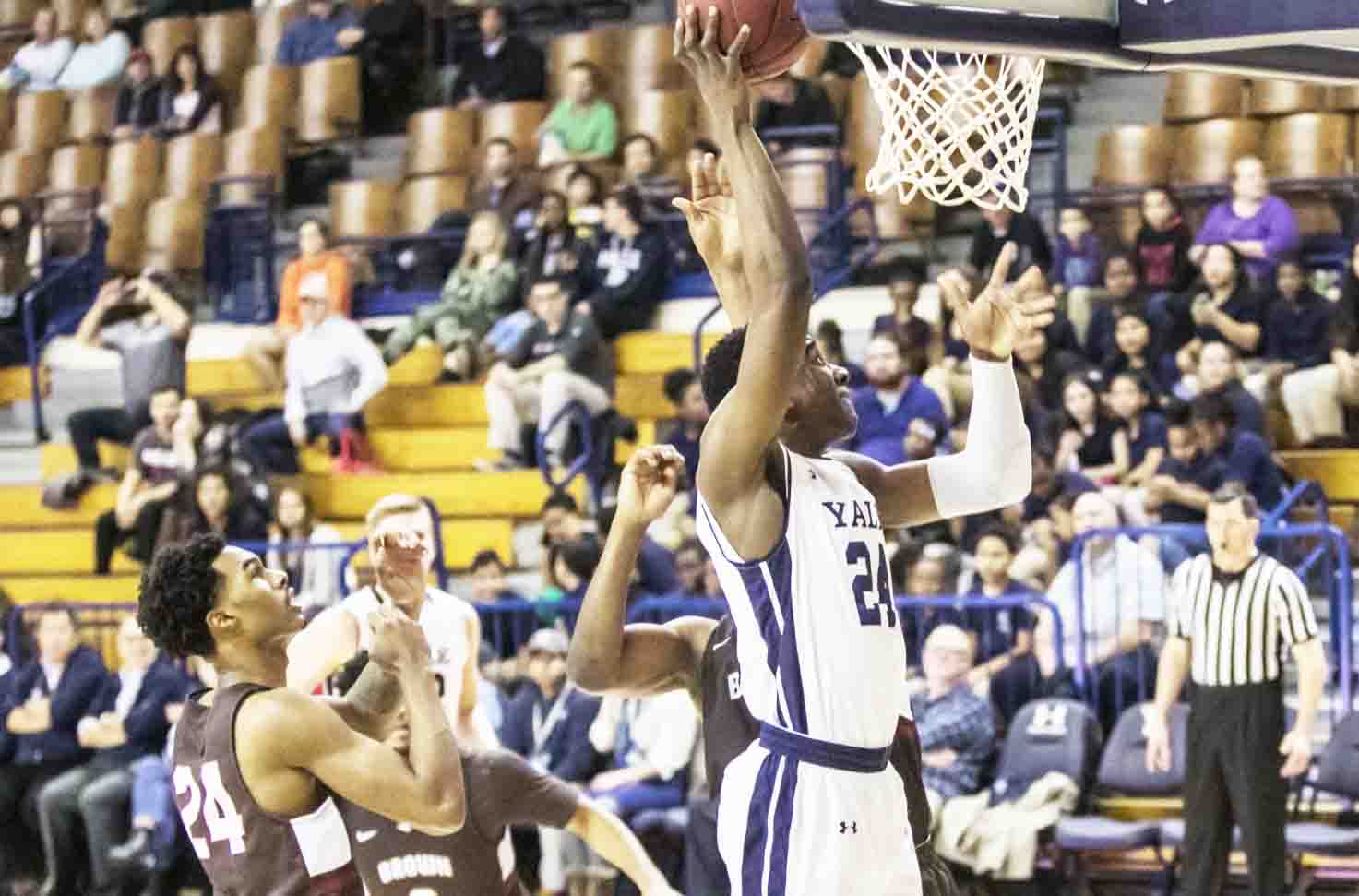
Yale Athletics
This was supposed to be a watershed season for the Yale men’s basketball program — a season that elevated the Elis from Cinderella upstart to repeat March Madness qualifier.
Two seasons removed from their first NCAA Tournament win in program history, the Bulldogs were slated to return star point guard Makai Mason ’18, who missed all of the 2016–17 season with a foot injury, and an emerging crop of young talent that, even in Mason’s absence, propelled the team to the finals of the Ivy League Tournament last season. In October, Yale earned the most first-place votes in the Ivy League Media Preseason Poll.
But in one fell swoop, an injury setback for Mason and a season-ending meniscus tear to up-and-coming forward Jordan Bruner ’20 before the start of the season changed everything for the Bulldogs. Although top-notch contributions from the junior class have kept the Elis afloat, head coach James Jones’s team split the season series with Brown, which did not make the four-team conference tournament a season ago. Perhaps more importantly, the team finds itself searching for an identity.
“I think we’re still in the process of finding it right now,” guard Miye Oni ’20 said. “Once we do, I think we’ll be a lot better. We need to play defense first. Once we start playing defense, everything else will sort itself out — maybe that could be our identity.”
Defense was the buzzword for the team after an 81–80 defeat to Brown last Friday. Entering halftime with a 38–33 lead, the Bulldogs gave up 48 points in the second half, even as they held Brandon Anderson, the league’s second-leading scorer, to just two points in the final 20 minutes. The Bears shot 31 free throws in each of the games they played against the Blue and had six players score at least nine points in their victory. In Yale’s 10 losses this season, opponents have scored an average of 83 points.
Along with rebounding and sharing the ball, defense is one of the three core principles of Jones’s program, but the team has yet to deliver a complete defensive game against top competition.
“If I could quote the movie ‘Hoosiers,’ ‘we got caught watching the paint dry,’” Jones said after the Brown game. “We were watching as opposed to playing, and we gave them some opportunities that we really could’ve covered up, had we been a little bit more aware defensively … [Brown] puts a lot of pressure on the defense by driving the ball, and making sure you stay in front of them is hard. When that doesn’t happen, you commit fouls and you put them on the free throw line.”
Given the twin losses of Mason and Bruner, the onus of leading the defense — and the team in general — has fallen squarely on the shoulders of the junior class. Forwards Noah Yates ’18 and Eric Anderson ’18 join Mason as the other seniors on Jones’s roster. While Yates averages 18.5 minutes per game, his status as a second-year walk-on still leaves much of the leadership burden to the class of 2019.
Guard Trey Phills ’19 continues to receive the toughest defensive assignments, as he is widely regarded as the Elis’ top perimeter defender, but the defensive issues plaguing the team cannot be solved by one player. As Jones said, the name of the game is focus for the Bulldog defense — not focus by one player or for spurts at a time, but focus by all five players for all 40 minutes of action.
“All of us together as upperclassmen, we’re trying to lead by example because we’ve been here.” Phills said. “We’ve been integral parts of the team as sophomores, so we know the ropes, [and] we’re just trying to lead by example right now. Makai is still around and helping us out vocally, but you need some on-court presence, and we’re trying to do that as a unit.”
For the moment, it appears Yale will need to rely on its high-scoring and efficient offense while its defense works itself out. Through 18 games, the Bulldogs rank third in the Ancient Eight in points per game, less than one point per game shy of the league-leading Quakers. Yale also boasts the highest shooting percentage and assist-per-game average in the conference.
Oni, who was expected to take on a larger offensive role after a second-team All-Ivy rookie campaign, leads Yale in scoring with 16.4 points per game. He and forward Blake Reynolds ’19 have been integral to setting up the offense and distributing the ball, as the two lead the team in assists.
With such a high assist rate, however, the offense is not limited to just one player’s contributions. Several players, from Oni and Reynolds to Phills and guard Alex Copeland ’19, are capable of leading the team in scoring on any given night. Even first years Paul Atkinson ’21 and Azar Swain ’21 have found themselves consistently scoring in Jones’s system.
“Our team, we have so many threats offensively,” Copeland said. “When one guy gets going, and they try to focus on him, it opens things up for everyone else. We’re a team that really roots for each other. We just really feed off each other’s energy, so when one guy gets going, then somebody else does too. We can be really dangerous that way.”
If Jones and his players can bring their defensive level of play up to their offensive level, it’s not far-fetched to think that they could still have a chance at a watershed season, especially with Mason’s return on the horizon. But the first step comes in embracing this defensive identity: one that everyone, from Jones on down to his players, realizes the team needs.
Won Jung | won.jung@yale.edu
Steven Rome | steven.rome@yale.edu







